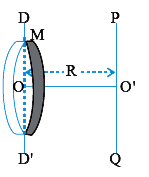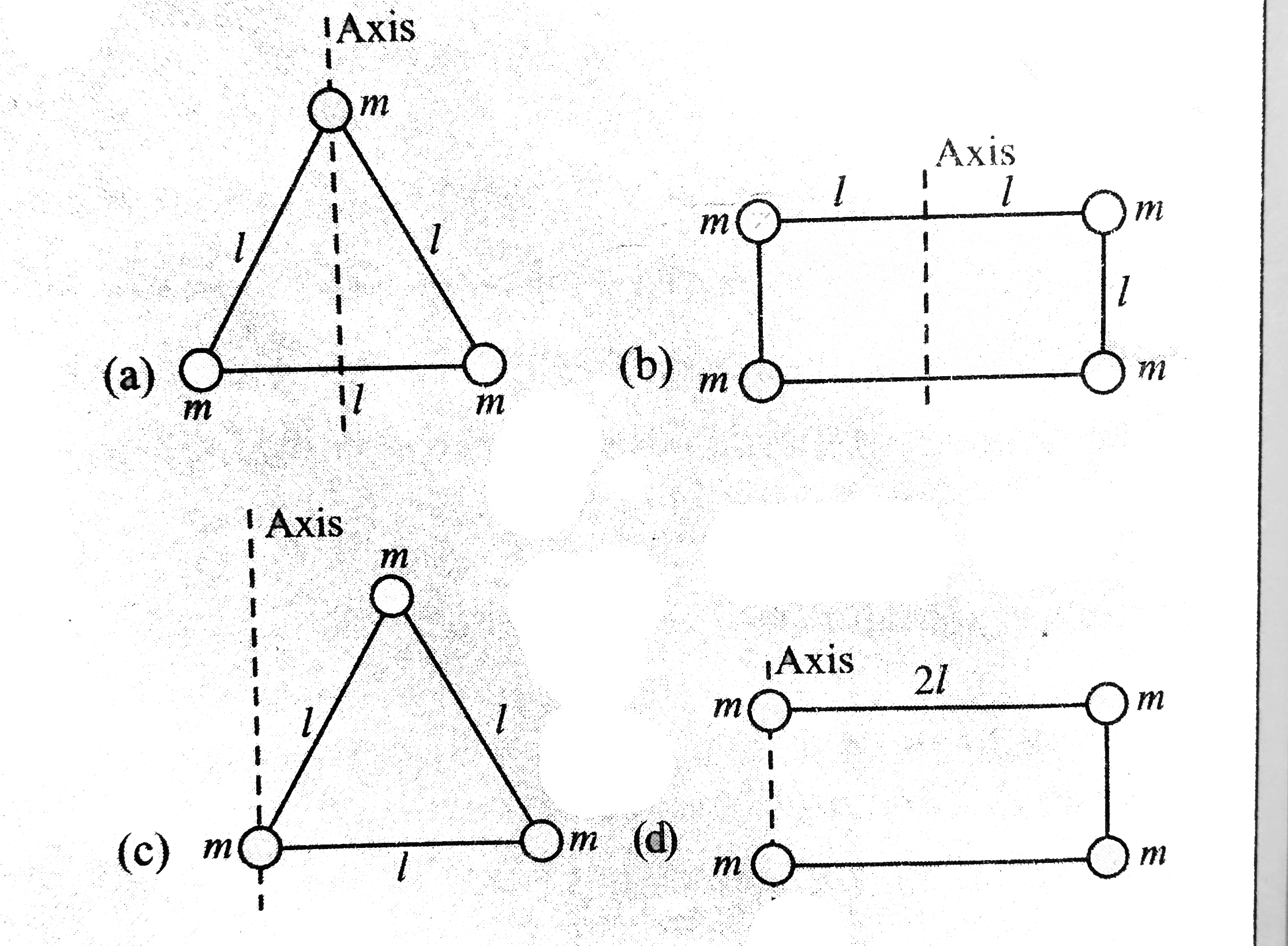A particle of mass 1 kg is kept at (1m,1m,1m). The moment of inertia of this particle about Z-axis would be
1kg-m2
2kg-m2
3kg-m2
None of these
The correct Answer is:B
To find the moment of inertia of a particle about the Z-axis, we can follow these steps:
1. Identify the mass and position of the particle:
The mass m of the particle is given as 1 kg, and its position is at coordinates (1m,1m,1m).
2. Understand the moment of inertia formula:
The moment of inertia I about the Z-axis is given by the formula:
Iz=m⋅R2z
where Rz is the perpendicular distance from the Z-axis to the particle.
3. Calculate the distance Rz:
Since the Z-axis is perpendicular to the XY-plane, the distance Rz can be calculated using the coordinates of the particle in the XY-plane. The coordinates of the particle are (1,1) in the XY-plane. The distance Rz is given by:
Rz=√x2+y2
Substituting the values:
Rz=√12+12=√1+1=√2m
4. Substitute Rz into the moment of inertia formula:
Now substituting Rz back into the moment of inertia formula:
Iz=m⋅R2z=1kg⋅(√2m)2
5. Calculate Iz:
Iz=1⋅2=2kg m2
6. Conclusion:
Therefore, the moment of inertia of the particle about the Z-axis is:
Iz=2kg m2
Final Answer:
The moment of inertia of the particle about the Z-axis is 2 kg m².
---
The mass m of the particle is given as 1 kg, and its position is at coordinates (1m,1m,1m).
The moment of inertia I about the Z-axis is given by the formula:
Iz=m⋅R2z
where Rz is the perpendicular distance from the Z-axis to the particle.
Since the Z-axis is perpendicular to the XY-plane, the distance Rz can be calculated using the coordinates of the particle in the XY-plane. The coordinates of the particle are (1,1) in the XY-plane. The distance Rz is given by:
Rz=√x2+y2
Substituting the values:
Rz=√12+12=√1+1=√2m
Now substituting Rz back into the moment of inertia formula:
Iz=m⋅R2z=1kg⋅(√2m)2
Iz=1⋅2=2kg m2
Therefore, the moment of inertia of the particle about the Z-axis is:
Iz=2kg m2
The moment of inertia of the particle about the Z-axis is 2 kg m².
Topper's Solved these Questions
- ROTATIONBOOK - DC PANDEY ENGLISHCHAPTER - ROTATIONEXERCISE - Check point 9.2
20 Videos
- ROTATIONBOOK - DC PANDEY ENGLISHCHAPTER - ROTATIONEXERCISE - Check point 9.3
15 Videos
- ROTATIONBOOK - DC PANDEY ENGLISHCHAPTER - ROTATIONEXERCISE - (C) Chapter Exercises
39 Videos
- RAY OPTICSBOOK - DC PANDEY ENGLISHCHAPTER - RAY OPTICSEXERCISE - Integer type q.
14 Videos
- ROTATIONAL MECHANICSBOOK - DC PANDEY ENGLISHCHAPTER - ROTATIONAL MECHANICSEXERCISE - Subjective Questions
2 Videos
Similar Questions
A mass of 1 kg is placed at (1m, 2m, 0). Another mass of 2 kg is placed at (3m, 3m, 0). Find the moment of inertial of both the masses about z-axis
View SolutionTwo partcles of masses 1 kg and 2 kg are placed at a distance of 3 m. Moment of inertia of the particles about an axis passing through their centre of mass and perpendicular to the line joining them is (in kg−m2) a) 6 b) 9 c) 8 d) 12
View SolutionThe moment of inertia of a ring of mass M and radius R about PQ axis will be

View SolutionThe moment of inertia of a rod about an axis through its centre and perpendicular to it, is 112ML2 (where, M is the mass and L is length of the rod). The rod is bent in the middle, so that two halves make an angle of 45∘. The moment of inertia of the bent rod about the same axis would be
View SolutionThe moment of inertia of a rod about an axis through its centre and perpendicular to it, is 112ML2 (where, M is the mass and L is length of the rod). The rod is bent in the middle, so that two halves make an angle of 60∘. The moment of inertia of the bent rod about the same axis would be
View SolutionMass centers of a system of three particles of masses 1,2,3kg is at the point (1m,2m,3m) and mass center of another group of two partices of masses 2kg and 3kg is at point (−1m,3m,−2m). Where a 5kg particle should be placed, so that mass center of the system of all these six particles shifts to mass center of the first system?
View SolutionThree point masses m1,m2 and m3 are located at the vertices of an equilateral triangle of side α. What is the moment of inertia of the system about an axis along the altitude of the triangle passing through m1?
View SolutionThree point masses m1,m2 and m3 are located at the vertices of an equilateral triangle of side α. What is the moment of inertia of the system about an axis along the altitude of the triangle passing through m1?
View SolutionA light rod of length l has two masses m1 and m2 attached to its two ends. The moment of inertia of the system about an axis perpendicular to the rod and passing through the centre of mass is.
View SolutionCalculate the moment of inertia of each particle in Fig. about the indicated axis of rotation.

View Solution
